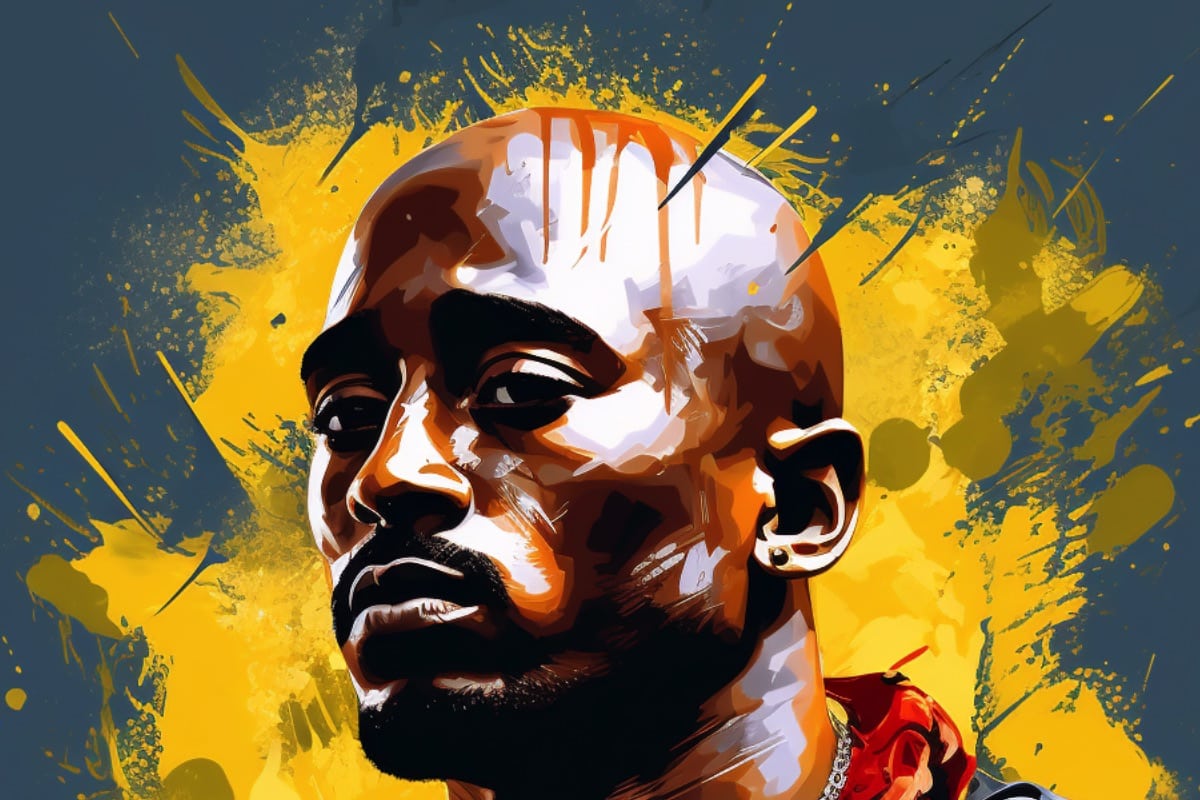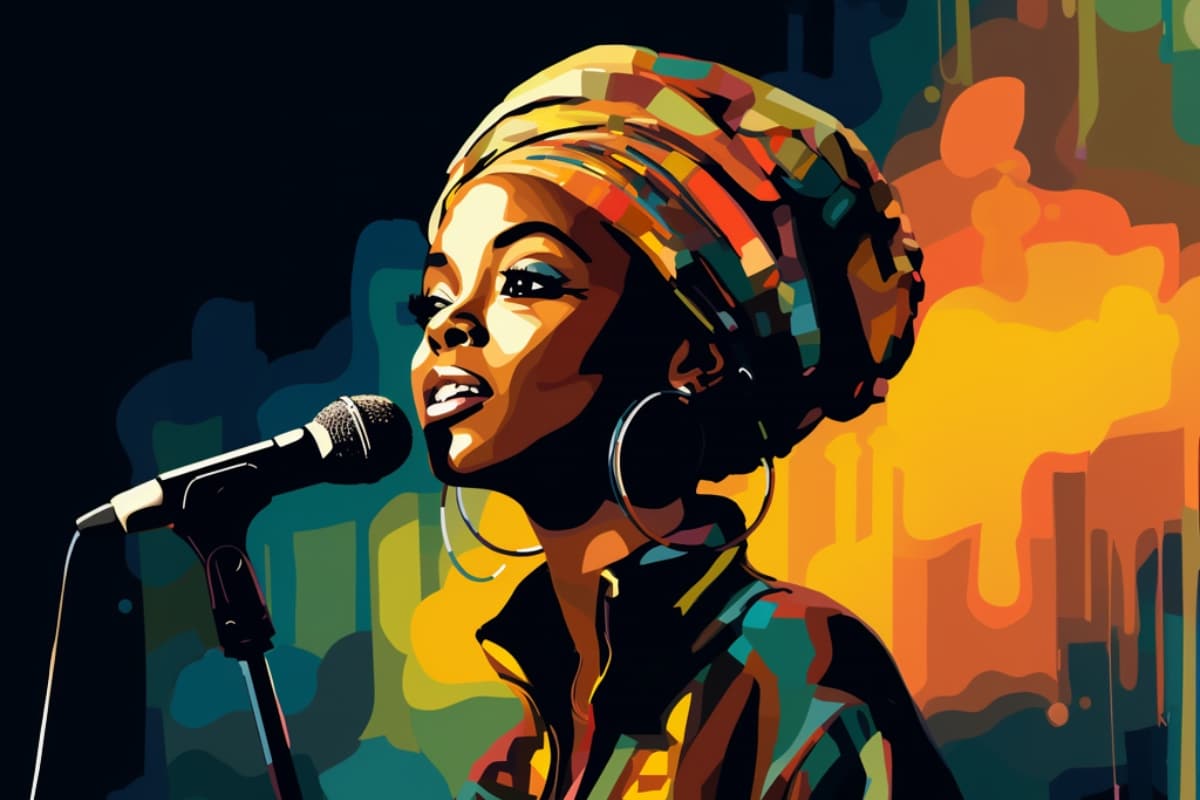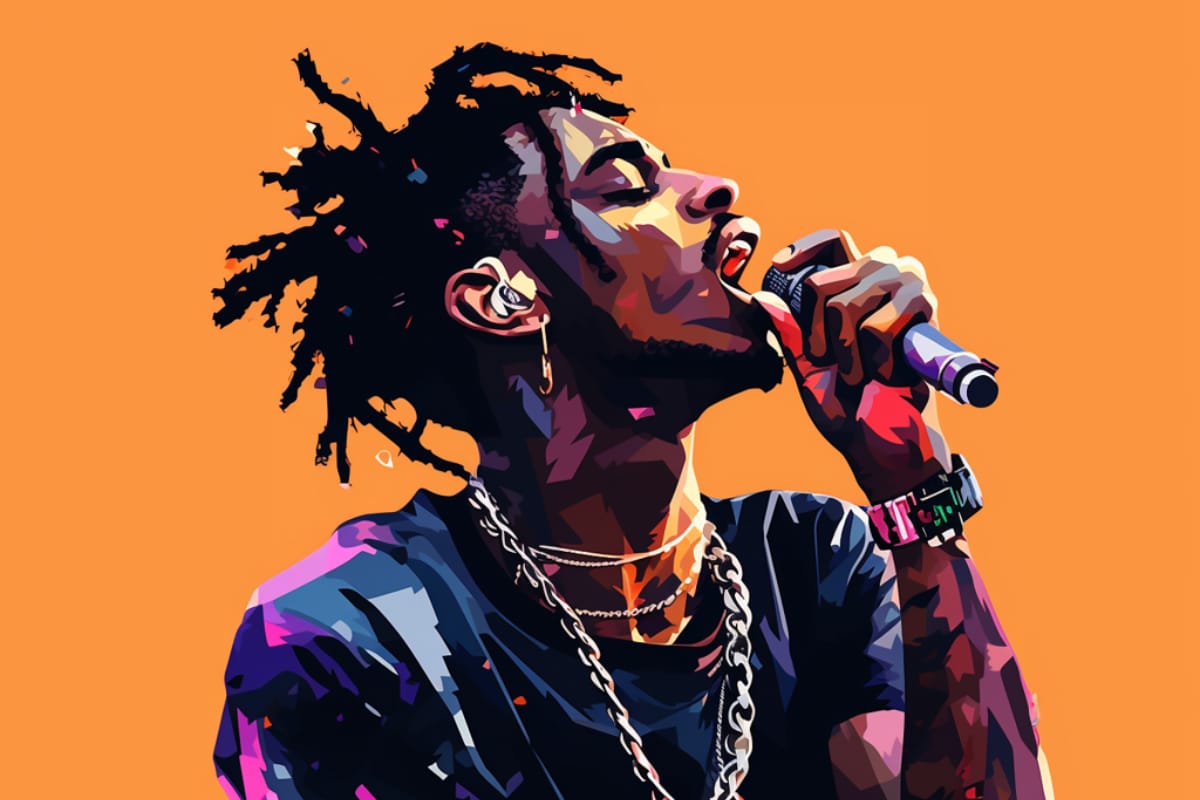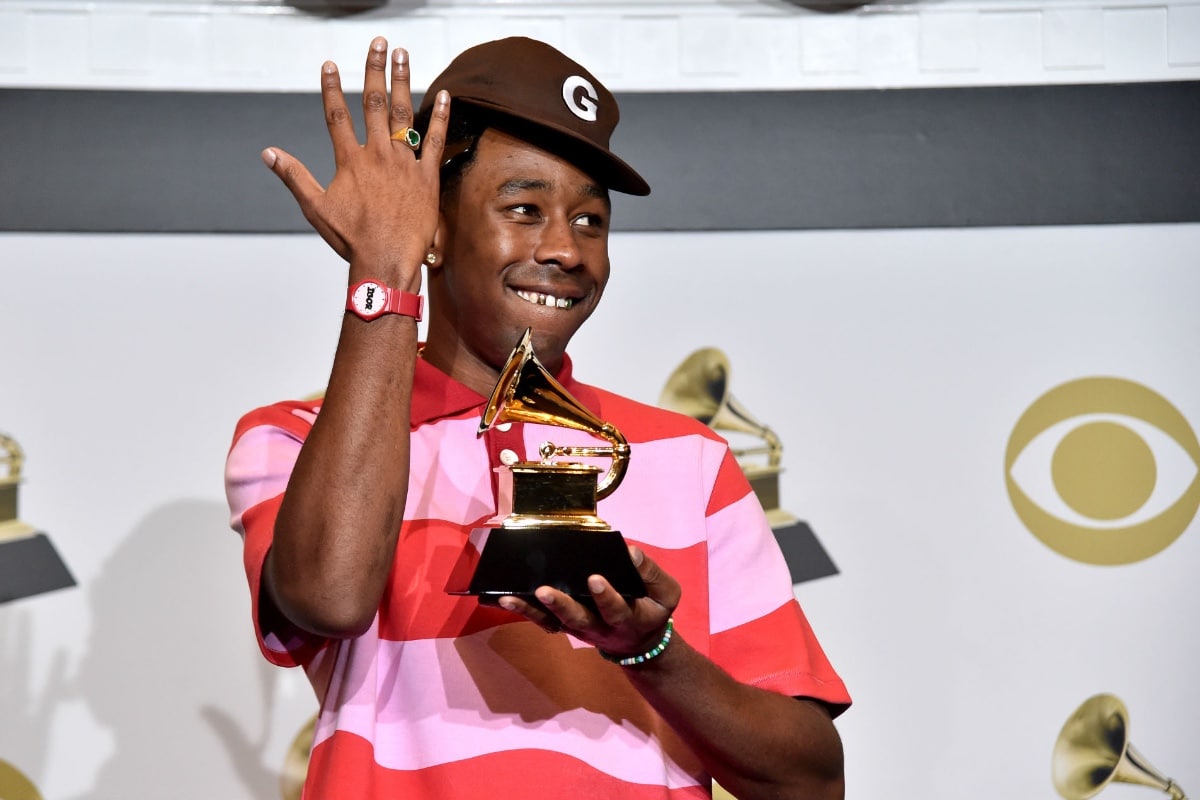Tupac Shakur, or simply “Pac,” as he’s often affectionately referred to, blazed through the rap scene like a comet in the 90’s, leaving behind a trail of brilliance that still lights up the music universe. Starting off with the playful rhythms of Digital Underground, his musical journey was intense, controversial, and, sadly, all too short.
Yet, Tupac’s legacy is timeless. His music wasn’t just about rhythm and rhyme; it was a revolutionary cry, a poetic narration of street tales, and a clarion call for change. From Artists like Eminem and 50 Cent to Kendrick Lamar and J. Cole, there have been countless rappers inspired by Pac’s words, activism and work ethic; they have all drawn from Pac’s deep well of wisdom which is a testament to his enduring influence. Dubbed by many as the voice of his generation, it’s no surprise he’s heralded as the definitive rapper of the ’90s and that’s why we picked Pac for the best rapper of the ’90s. Along the way, he also managed to become one of the best-selling rappers of all time with a deep catalogue of multiplatinum albums. With a sales record that rivals legends and a discography that’s richer than most, Tupac’s albums remain a masterclass in rap.
Pac left a lasting impact on music and culture for decades to come, and those short years of his prime were enough to cement him as one of the greatest rappers of all time.
Now, let’s take a deep dive into the ocean of Tupac’s soundscape. From the raw, unfiltered emotions of his debut, 2Pacalypse Now, to the haunting refrains of his posthumous releases, here’s a curated ranking of Tupac’s most iconic albums.
Pac’s Life (2006)
Essential listening: “Untouchable”, “Pac’s Life”, “Playa Cardz Right”
Pac’s Life (2006)
A decade after Tupac’s tragic passing, “Pac’s Life” emerged, glistening with posthumous magic. This album was an embodiment of what Tupac represented — a mélange of raw street tales, soulful reflections, and revolutionary fervor. Featuring collaborations with modern-day heavyweights like Ashanti, T.I., and Ludacris, it was a testament to Pac’s timeless appeal and his ability to resonate across eras.
The tracks served as reminders of Tupac’s lyrical dexterity, and while some purists argued that the posthumous collaborations might not align with Pac’s original vision, it’s undeniable that the essence of his spirit danced through each track. Songs like “Untouchable” and “Playa Cardz Right” exemplify the juxtaposition of the old and the new, offering a fresh spin while keeping the Tupac ethos alive.
“Pac’s Life” was a celebration, a tribute, and a poignant reminder of a legend gone too soon, but whose voice will echo eternally in the annals of hip-hop.
2Pacalypse Now (1991)
Essential Listening: “Trapped”, “Brenda’s Got a Baby”, “If My Homie Calls”
Ah, the genesis! “2Pacalypse Now” is where it all began, the raw and unfiltered introduction of Tupac Shakur to the world. This album wasn’t just a debut; it was a declaration, a battle cry against systemic injustice, police brutality, and the challenges of inner-city life. Lacking the polish of his later works, its rough edges made it all the more authentic, a straight-from-the-heart outpouring.
Tracks like “Brenda’s Got a Baby” and “Trapped” showcased Tupac’s storytelling prowess, his ability to weave intricate narratives that held up a mirror to society’s grim realities. His poetic inclinations, which would later become his hallmark, were evident even then. For many, this album was a wakeup call, touching on themes that were rarely aired so openly in the mainstream.
“2Pacalypse Now” is Pac in his nascent stage, yet displaying the depth and vision that would cement his legacy as a hip-hop icon. This was the thunderous first note in what would become a symphony of rebellion and reflection.
Loyal to the Game (2004)
Essential listening: “Thugs Get Lonely Too”, “Ghetto Gospel”
Produced by the rap god himself, Eminem, “Loyal to the Game” is one of Tupac’s most debated posthumous releases. Dropping almost a decade after his untimely departure, this album presented a unique blend of Pac’s original verses with contemporary beats and collaborations. It was like glimpsing Tupac through a modern lens, a blending of epochs.
Tracks like “Ghetto Gospel,” featuring the iconic Elton John, gave fans a taste of what could have been – Tupac’s lyrical genius set against a backdrop of modern production magic. The title track, “Loyal to the Game,” with G-Unit, epitomized Tupac’s undying allegiance to the streets and the game of rap.
However, it’s worth noting that the album received its share of criticism, with some fans feeling the posthumous remixes didn’t do justice to Pac’s original intent. But agree or disagree, “Loyal to the Game” stands as a testament to Tupac’s enduring relevance in an ever-evolving music landscape. A sonic resurrection, if you will, bridging two eras of hip-hop royalty.
Strictly 4 My N.I.G.G.A.Z… (1993)
Essential listening: “Holler If Ya Hear Me”, “I Get Around”, “Keep Ya Head Up”, “Papa’z Song”
“Strictly 4 My N.I.G.G.A.Z…” dropped in ’93, making it clear that Tupac was no flash-in-the-pan artist. This was the album where Pac began to truly hone his voice, blending politically-charged anthems with the gritty realities of street life. It was both a celebration and a critique, showing Tupac’s dual role as both party-starter and conscientious observer.
“Holler If Ya Hear Me” was a defiant anthem, a fist raised against the system. On the other end of the spectrum, “Keep Ya Head Up” showcased Tupac’s softer side, an ode to struggling women everywhere. And then there was “I Get Around,” a laid-back, playful track that showed Tupac’s versatility and charisma.
“Strictly 4 My N.I.G.G.A.Z…” was Tupac further asserting his position in the rap game, a tapestry of anger, hope, revelry, and introspection. It wasn’t just an album; it was a statement, a glimpse into the soul of an artist unafraid to bare it all. This was Tupac: unapologetic, fierce, tender, and always, always real.
Tupac: Resurrection (2003)
Essential listening: “Runnin’ (Dying to Live)”, “One Day at a Time (Em’s Version)”
Tied to the documentary of the same name, “Tupac: Resurrection” wasn’t just another posthumous album — it was an auditory journey through the life of one of hip-hop’s most revered figures. Serving as the film’s soundtrack, the album cleverly wove together interview snippets, unreleased tracks, and remixed gems, crafting a narrative that gave fans an intimate look into Tupac’s world.
“Ghost” and “One Day at a Time” are just two of the standout tracks, resonating with Tupac’s unyielding spirit and insatiable hunger for change. The collaboration with Eminem on “Runnin’ (Dying to Live)” — which also featured The Notorious B.I.G. — was especially poignant, reminding listeners of the tragic losses hip-hop suffered in the ’90s.
“Resurrection” did more than just spotlight Tupac’s musical prowess; it painted a portrait of the man behind the legend. For fans new and old, it was a deep dive into the psyche of an icon, a resurrection not just of Tupac’s music, but of his indomitable spirit.
Still I Rise w/ the Outlawz (1999)
Essential listening: “Baby Don’t Cry (Keep Ya Head Up II)”
Oh, when legends collide! “Still I Rise,” a collaborative effort between Tupac and the Outlawz, is a testament to the camaraderie and synergy these artists shared. Released three years after Tupac’s passing, this project served as a poignant reminder of the rapper’s indomitable spirit and his vision of unity in the face of adversity.
Tracks like “Baby Don’t Cry (Keep Ya Head Up II)” resonated with Tupac’s classic empathetic touch, while “Hell 4 a Hustler” was an anthem for every dreamer trapped in the unforgiving grind. This album seamlessly meshed Tupac’s raw, introspective verses with the Outlawz’s fiery passion, creating a potent brew of street anthems and soulful reflections.
“Still I Rise,” beyond its musical prowess, stood as a symbol — even in death, Tupac’s voice would not be silenced. With the Outlawz by his side, this album solidified that Tupac’s flame, rather than being extinguished, was being carried forward, lighting the way for the next generation.
Better Dayz (2002)
Essential Listening: “Thugz Mansion”, “Still Ballin”
By the time “Better Dayz” hit the shelves in 2002, Tupac’s posthumous releases were creating a sense of anticipation tinged with nostalgia. This double album was an ode to hope, a beacon in times of darkness, and a lyrical masterpiece showcasing Pac’s visionary prowess.
Tracks like “My Block (Remix)” encapsulated the spirit of perseverance, painting vivid pictures of the streets Tupac knew so intimately. Then there’s “Thugz Mansion,” a soulful reflection where Pac imagines a peaceful haven for the weary. It’s introspective Tupac at his finest, exploring the concept of peace amidst chaos.
But let’s be real – it wasn’t all introspection. “When We Ride On Our Enemies” is Pac in full battle mode, reminding everyone that he was as fierce in his confrontations as he was in his calls for unity.
“Better Dayz” is an exploration of duality, of the thin line between struggle and salvation, offering solace and strength in equal measure. It’s a reminder that even in the darkest times, better days are on the horizon, especially if Tupac’s guiding the way.
R U Still Down? (Remember Me) (1997)
Essential listening: “I Wonder If Heaven Got a Ghetto”, “Do for Love”
Ah, “R U Still Down? (Remember Me),” the posthumous double album that felt like a direct line to Tupac’s soul. Released just a year after his tragic passing, it was as if Pac was reaching out from the beyond, asking us if we still remembered, still vibed, still held onto the truths he’d laid down. And, of course, we did. We still do.
With tracks like “Do for Love,” the album showcased Tupac’s signature blend of heartfelt sentiments and irresistible hooks. While “Hellrazor” showcased a sharper, more confrontational side of Tupac, his depth and range were evident in every bar.
Importantly, this wasn’t just a collection of leftover tracks thrown together. “R U Still Down?” was a cohesive project, a fully realized vision from a man who had so much more to say. It’s a testament to Tupac’s immense talent that even after his passing, he could drop an album that felt fresh, relevant, and so unmistakably him. In a world hungry for authenticity, Tupac asked, “R U Still Down?” And the answer? A resounding “Always.”
Until the End of Time
Essential listening: “Happy Home”, “Until the End of Time”, “Letter 2 My Unborn”
By 2001, the world had been mourning the loss of Tupac for half a decade, but “Until the End of Time” burst onto the scene and made it feel as if he’d never left. This double album wasn’t just a reminder of Tupac’s genius; it was a reaffirmation of his eternal relevance.
The title track, sampling the timeless “Broken Wings” by Mr. Mister, was pure Tupac magic: introspective, deeply emotional, with a touch of defiance. It’s the kind of song that gives you chills, bringing Tupac back to life, if only for a few minutes.
“Letter 2 My Unborn,” on the other hand, was a poignant reflection on fate, legacy, and the uncertainty of life, showcasing Pac’s ability to touch on universal themes with unmatched eloquence.
What’s striking about “Until the End of Time” is its raw authenticity. Even the posthumous production felt true to Tupac’s essence, balancing street anthems with soul-stirring ballads. In essence, this album was a proclamation: Tupac’s voice, his message, his artistry, would resonate ‘until the end of time.’ And trust, we’re here for it, every beat and bar.
Me Against the World
Essential listening: “Dear Mama”, “So Many Tears”, “Temptations”
“Me Against the World” is more than just an album; it’s an ethos, a state of mind, and for many, a way of life. Released in ’95, smack in the midst of Tupac’s prison sentence, it remains one of the most personal and introspective pieces of work in hip-hop history. This was Tupac at his most vulnerable, grappling with his demons, his destiny, and the harsh realities of the world around him.
The title track is a haunting soliloquy of defiance, while “Dear Mama” is an ode that resonates with anyone who’s ever had a mother – raw, emotional, and deeply touching. And then there’s “So Many Tears,” a mournful reflection on mortality and the trials of life.
“Me Against the World” stands out in Pac’s discography because of its unfiltered emotion and searing honesty. At a time when bravado ruled the rap game, Tupac stripped away the facade, revealing the man behind the legend. It’s a monumental album, not just in Pac’s career, but in the annals of hip-hop. This was Tupac laying it all on the line, making sure that even if it felt like it was him against the world, he wouldn’t face it silently. A masterpiece, period.
The Don Killuminati: The 7 Day Theory
Essential listening: “Toss It Up”, “To Live & Die in L.A.”, “Hail Mary”
Just weeks after Tupac’s tragic departure from this world, “The Don Killuminati: The 7 Day Theory” erupted from the shadows. Legend has it, this entire album was crafted in just seven days. And if that doesn’t speak volumes about Pac’s unmatched work ethic and brilliance, what does?
It’s more than an album; it’s a sonic conspiracy, laden with cryptic messages and laced with raw emotion. “Hail Mary” isn’t just a track; it’s a haunting prayer from the depths of Tupac’s soul, melding aggression with reflection. “Toss It Up” gave us a taste of Tupac’s playful side, despite the overarching grim tone of the album.
Then there’s “Against All Odds,” a track that underscores the tension and paranoia that seemed to follow Tupac. It’s both a poignant farewell and a defiant stand against his foes.
“The 7 Day Theory” is often viewed through a lens of mysticism given its posthumous release, but strip away the conspiracy theories and you’re left with pure, unadulterated Tupac. It’s a chilling reminder that even in his final days, Tupac was a force to be reckoned with, laying down tracks that would immortalize him as a rap deity.
All Eyez on Me
Essential listening: “California Love”, “2 of Amerikaz Most Wanted”, “How Do U Want It”, “I Ain’t Mad at Cha”
Two discs, 27 tracks, one undeniable legend. “All Eyez on Me” wasn’t just an album; it was a declaration. Released shortly after Tupac’s release from prison in 1996, it was clear: Pac was out, and he was here to conquer.
Let’s get this straight: “All Eyez on Me” is the magnum opus, the zenith of Tupac’s career. From “Ambitionz Az a Ridah” with its hypnotic beat and braggadocious lyrics, to the smooth groove of “How Do U Want It,” every track was a statement.
“Life Goes On” provided solace in the face of death, while “I Ain’t Mad at Cha” delved into personal growth and changing relationships. And who could forget the West Coast anthem, “California Love,” with Dr. Dre? It’s an infectious celebration of Cali life, ensuring the party never stopped.
This was Tupac at his most unfiltered, unapologetic, and unparalleled. It’s a sprawling epic, a snapshot of a man at the peak of his powers, keenly aware that the world was watching. “All Eyez on Me” is not just one of Tupac’s greatest accomplishments; it’s one of hip-hop’s crowning jewels. If you ever questioned Tupac’s GOAT status, one spin of this masterpiece should lay any doubts to rest.








